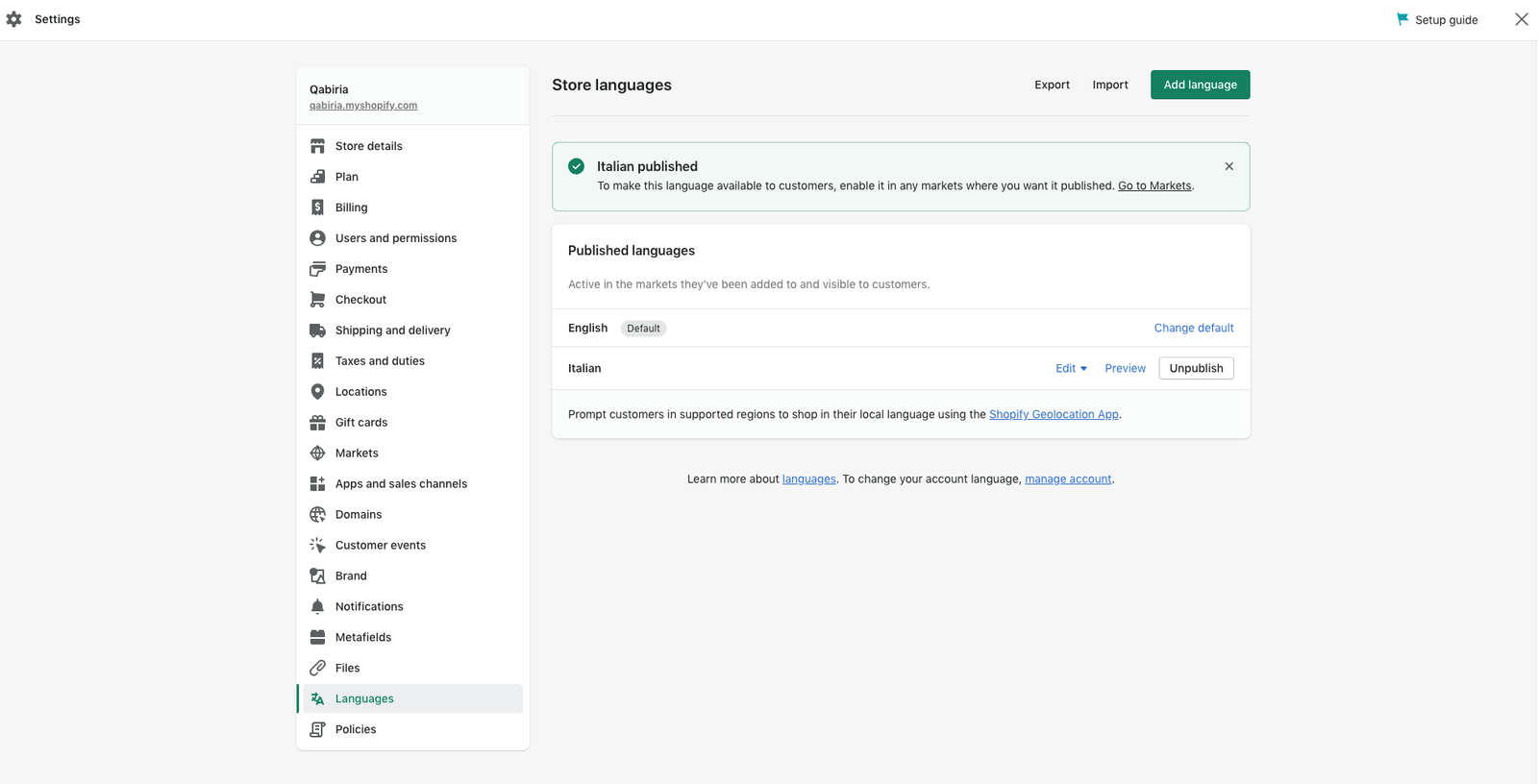
Translating an online store created by Shopify seems an easy task. However, many technical issues must be faced and solved in order to go from a monolingual e-commerce to a multilingual one.
Shopify’s official documentation is fairly complete and covers most cases, but the information about the steps and the solutions to translate an e-commerce is scattered over a dozen different pages.
This ultimate guide gathers together on one page all the indication on:
- How to translate topics, pages, products and categories
- How to manage currencies
- How to manage shipping settings How to create a milutilingual navigation system How to manage dynamic content, such as blogs and reviewers.
Thanks to this guide, you will learn how to solve all the issues and how to provide a smooth and clear experience for your worldwide customers. In fact, you will give them the possibility to surf and buy products easily and intuitively in their own language.
Table of Contents
Is it better to create multiple stores or a single multilingual store?
The first decision to be made is: Should I create a store for each language/country or is it better to have just one multilingual store?
Before converting your store into a multilingual one, you must decide if it is better for you:
- To have multiple Shopify stores and for each of them a different language, or
- To have just one site that is the same for everyone and it is managed by Shopify’s multilingual option.
Se prevedi differenze di prezzo e di catalogo a seconda dei paesi, allora la scelta migliore è quella di creare domini diversi. If you set up your store for Spain, for example, you will have the domain [dominio.es] and only the Spanish users will be redirected to it.
This choice involves more management and updating work. A new feature, that is called Shopify Markets, will be released soon. Thanks to it, you will have the possibility of managing multiple domains in a single store.
On the other side, if the catalog is the same for all the countries, then you have to set up one multilingual site. Let’s see how it works..
What are the translatable items in Shopify?
The translatable items of a Shopify store can be divided into three types of texts:
- the texts of the platform interface
- the texts added to the theme, that allow surfing
- the texts created by the site administrator, that is product sheets, pages and all the emails you send to customers.
Translating Shopify’s interface
The texts of Shopify’s interface are those related to the functionality of the platform.
They are pre-translated directly by the system. The administrator site only need to add and activate the new language.
Go to the section Configuration > Store Languages. Set the default language here, that is, the one displayed by default by visitors, and add as many as you need.

Translating a Shopify theme
Before choosing a theme for your Shopify store, you should verify that it has been designed for a multilingual store. We strongly advise against trying to adapt a theme that has not been designed to be multilingual. It is better to choose another one.
In general, translatable texts contained in a theme are those related to user actions. They can refer to the menu, icons, shopping cart, payment stage, etc.
Most popular themes are distributed with their own translation of these texts in several languages. Languages can be activated in the section Configuration > Store Languages, as any other.
Translations distributed with the theme aren't always professional or error-free. Always let a professional translator or your [translation company]/translation/professional-translation) check the theme strings.

Shopify themes can contain translatable content in 3 different formats, the same as on any Shopify site:
- Normal text
- HTML code
- Liquid code.
The code Liquid is a peculiar Shopify feature. It’s an open source programming language open created by Shopify itself and written in Ruby. It is precisely used for creating dynamic templates and loading dynamic content into themes, such as calculating discounts and showing original, discounted prices. It basically acts as a bridge between the HTML and the data store.
Usually Liquid files have the extension .liquid and follow a special syntax that mixes HTML and constructs in curly brackets, as in the following example:
<title>
{{ page_title }}
</title>
{% if page_description -%}
<meta name="description" content="{{ page_description | truncate: 150 }}">
{%- endif %}The double curly bracket {{ }} shows the value of the retrieved object, while the constructs delimited by double curly brackets and percentage sign {% ... %} indicate the logic.
If the theme has been projected correctly, it won't be necessary to intervene in the Liquid code, but if some text string has been hard-coded you will need to be familiar with this language in order to intervene at the code level.
How to translate a Shopify theme with Translate & Adapt app
If the theme chosen doesn't have the language you need, you can create the translations on your own.
- Login to your Shopify store and to the section
Appof the administration panel.
- Search for the Translate & Adapt app and click
Add appin order to install it. - Once installed, clic on
Apps > Translate & Adapt.
- Click on the
Machine translationbottom in the upper right corner. - Select the language in which you want to translate e click
Translate. - Once completed the machine translation, in the same section of the Translate & Adapt app, choose the option
Theme assets> Edit
- In this section, you can automatically translate content through the option
Auto-translatein the upper right corner. If you don't want to use machine translation, translate manually all the text strings.
It is important to take special care when translating blocks of text containing HTML or Liquid code. Make sure not to change file structure or references, as this may cause errors in the theme.
How to translate products in a Shopify e-commerce
Once the theme has been translated or configured, it is time to face the content translation.
Shopify doesn't offer a native solution to create a multilingual store. You have two options:
- manually translate all texts or
- translating with compatible Shopify or third-party apps.
I remind you that choosing to set up a multilingual store has some limitations:
- Tags, such as product tags, article tags, and blog tags, cannot be translated
- If you change the handle of a product, that is, the unique name assigned to each one, redirects for that product will not be supported by the language-specific URLs
- Product URLs, for example /products/large-white-t-shirt, are not translated and remain in the language in which they were created, even when a customer views the site in another language.
Manual translation of a Shopify e-commerce
Manual translation means exporting, translating, and importing translated content via a CSV file. The process to follow is simple:
- From the Shopify control panel, head to the
Settingssection. - Click on
Languages. - Click
Export. - Select the language you wish to export. You can select
All Languagesto export translations for all supported languages. - Select one of the following options:
- Select
All Contentto export all translations. - Select
Metafieldif you use metafields (custom fields) to add content to the store. - Select
Obsoleteif you have already added translations to the store and wish to export translations that have not been updated from the default language. - Select
Untranslated Contentto export only content that is currently untranslated.
- Select
-
Click on
Export. The exported CSV file will be emailed to you.
The CSV file you will receive, contains the following columns:
- Type - the type of resource, such as Products, Articles, Collections, Pages, or Blogs.
- Identification - the resource ID.
- Field - the field, for example title, body_html or meta_title.
- Local (Local Settings) - the language in which the content is translated.
- Market - the market for which the content was created.
- Status - indicates whether the translation is obsolete.
- Default content - the original content to be translated.
- Translated content - the translated content. Translated content should be added here.
The CSV format offers clear advantages in terms of compatibility. It is a simple text format, and using it directly for translation into various languages may pose risks.
If a translator works on the CSV by opening it in a computer spreadsheet such as Microsoft Excel, when he saves it the line breaks, encoding, and field separator may be different from the original ones.
To avoid these problems, it is important to use specific software tools that allow you to isolate the untranslatable parts of the CSV file and expose only the textual content to translators. In this way, you will be able to avoid problems when importing CSV with content translated into another language on Shopify.
If you use a spreadsheet to edit the CSV file, make sure the default delimiter is set to comma instead of semicolon. In some cases, HTML codes with semicolons are included in the CSV export file, which may result in incorrect separation into columns of the content in the spreadsheet.
Once the CSV file is translated, you need to update the translated content of your store. Import the CSV file with the translation into the Shopify control panel, following these steps:
- From the Shopify control panel head to the
Settingssection. - Click on
Languages. - Click on
Import. - Click on
Add Fileand select the CSV file with the translations.- If you want the content in the translated language of the CSV file to replace existing translations, select
Overwrite any existing translations. - If you want to import only new translated content without replacing existing translations, uncheck
Overwrite any existing translations.
- If you want the content in the translated language of the CSV file to replace existing translations, select
- Click on
Load and continue. -
Check the information in
Import language with a CSV, then clickImport. If the CSV file contains errors, the import will be aborted and the errors will be listed on theImport language with a CSVpage.
You will be sent a confirmation email with a list of all translated content whose import was skipped or failed.
You will be sent a confirmation email with a list of all translated content whose import was skipped or failed.
In addition to manually, you can also translate your eshop content with Shopify apps or external tools.
Shopify’s translation plugins are apps that install on your page and allow automatic or manual translation of store content into different languages.
They are installed from the Languages section of the store. Here are some recommended ones to get you started.
Langify
In addition to its affordable price and intuitiveness, among the main advantages of the Langify app is the ability to import or export translations in bulk in CSV format. Langify allows translation of virtually every section of the site, with the exception of the check-out page and notifications received from users.
In addition, Langify includes SEO translation functionality and technical support is very responsive in case of problems. Price: $17.5 per month.
To learn more, watch this video tutorial on Langify.
Transcy
With Transcy you can select content to be translated and assign it to a [professional translator](/translation/professional translator) or use machine translation in more than 100 languages.
Transcy makes it easy to manage content translation, monitoring the status of translations in real time and receiving notifications when a translation is complete. Finally, with the translation preview you can check that all content has been translated correctly into the various languages. As for payments, it is able to update the currency to the exchange rate in real time.
Price: free plan up to 2000 words, then $17.90 per month.
To learn more, watch this video tutorial on Transcy.
Translation Lab - AI Translate
Translation Lab works with the new multilingual feature and is a native Shopify app, meaning it will work without manual intervention, no code will be added to your theme, and there will be no external control panel.
In addition to having full control over translations, Translation Lab is an SEO-friendly app: modifies not only the content, but also attributes such as the URL, meta description, meta tags, and other elements considered by search engines.
Price: the app is free.
To learn more, watch this video tutorial on Translation Lab.
Weglot
In addition to machine translation, Weglot also allows you to manage and customize translations manually. With Weglot you can translate all the types of text seen above, including checkout and e-mail notifications. It also automatically detects and translates any new content added or changed on your store and is compatible with all Shopify themes.
Price: free plan up to 2000 words, then €15 per month.
To learn more, watch this video tutorial on Weglot
URL e SEO
Translating a Shopify store is not only a matter of translating the texts, but also of adapting the content to the culture and language of the target audience.
When translating a Shopify e-commerce, time and attention must be spent on keyword research and adaptation to optimize search engine rankings (SEO).
URLs are an important SEO factor because they indicate to search engines the content of the web page. URLs describe the structure of the website and help search engines understand the content of web pages.
When you publish your store in a language, unique URLs are created for each translated page of your store.
For example, if your primary domain is shop.com, by adding the Spanish language to your store, your store URL becomes shop.com/es. The rest of the domain remains the same in all languages.
There are some best practices that you should follow to ensure that URLs and search engine optimization are appropriate:
- Use descriptive and meaningful URLs for different languages. For example, if you translate a product page called "Long Sleeve Shirt" from English to Italian, the URL of the translated page should look like
www.nomedeltuoecommerce.com/it/camicia-a-maniche-lungheinstead ofwww.nomedeltuoecommerce.com/it/product.1234. - Keep URLs consistent across languages. For example, if you translate the page
www.nameofyourecommerce/en/shirts/long-sleeve-shirtfrom English to Italian, the URL of the translated page should bewww.nomedeltuoecommerce.com/it/camicie/camicia-a-maniche-lungheand notwww.nomedeltuoecommerce/en/long-sleeve-shirt. - Use the hreflang tag: this tells search engines what version of the web page is most appropriate for a given user based on language and geographic location.
- Use an SEO-friendly translation plugin. An example would be Weglot, which offers features such as dynamic URL translation.
- It is equally important to make sure to adapt keywords for SEO in Italian to ensure that your store is easily found online.
What is Shopify?
Con sede a Ottawa, in Canada, Shopify è stata fondata nel 2006 dall’attuale CEO Tobias Lütke, insieme a Daniel Weinand e Scott Lake. Committed to wanting to create an e-commerce to sell snowboards, the three young Canadians soon realized the difficulties and the wide room for improvement in e-commerce software at the time. Faced with the scarcity of available software tools, they decided to create one. Since then, the company has not stopped growing in 2019, after surpassing eBay in the market, it became the highest-valued company in Canada.
According to data published by W3Techs, to date there are more than 1.75 million merchants using Shopify as their primary platform for selling online, ranking second only behind WordPress as the world’s most widely used CMS. In terms of statistics, Shopify is used by 3.9% of all websites.
Through three different subscription plans, Shopify provides all the tools needed to create and maintain an online store: from the web page, to the payment processor, to the shipping partner, as well as the ability to work in the back office and a control panel for marketing.
Do you have a Shopify-based e-commerce and want to sell overseas? Send us a message to explain what you need and we will help you.






